| Article ID | Journal | Published Year | Pages | File Type |
|---|---|---|---|---|
| 9089457 | Anaesthesia & Intensive Care Medicine | 2005 | 5 Pages |
Abstract
A number of activities and life events affect gas exchange. Fundamental to a number of these is the relationship between functional residual capacity and the lung volume at which small airways in the base of the lung start to close (closing capacity or volume), predisposing to hypoxaemia. In the young, erect individual this occurs at about 10% of vital capacity. With a decrease in functional residual capacity (anaesthesia, abdominal or thoracic surgery, obesity) or a rise in closing capacity (age, smoking, pulmonary oedema) small airway closure may occur during normal tidal ventilation, producing hypoxaemia. In exercise, demands are made on the cardiovascular and respiratory systems. The respiratory reserve is normally greater than the cardiovascular. The limitation to exercise capacity is usually the cardiovascular system, specifically the maximum heart rate. Oxygen consumption rises in proportion to exercise intensity, but above a certain level (the anaerobic threshold) the contribution of anaerobic metabolism to energy production increases and blood lactic acid levels increase. Beyond this point carbon dioxide production, compensating for the acidosis, rises disproportionately. Anaesthesia is normally associated with impairment of respiratory control and gas exchange. The fetal circulation has a number of specific vascular pathways not seen in the adult (foramen ovale, sinus venosus, ductus arteriosus). They are designed to maximize fetal cerebral oxygenation in the presence of relative hypoxaemia and they all close after birth.
Keywords
Related Topics
Health Sciences
Medicine and Dentistry
Anesthesiology and Pain Medicine
Authors
Iain Campbell, James Waterhouse,
